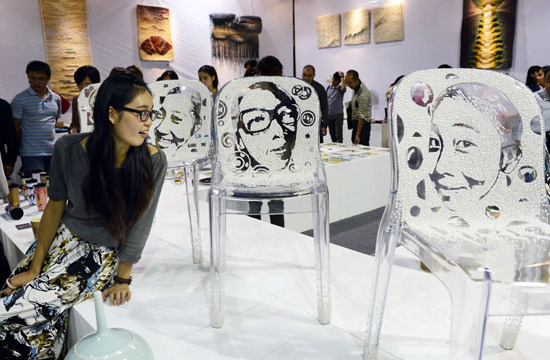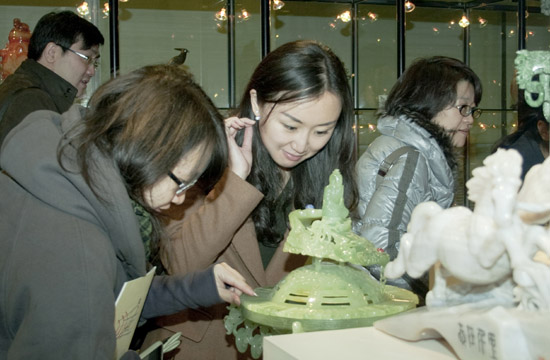|
 |
|
A woman gazes at a craft chair at the 2012 China Hangzhou Cultural and Creative Industry Expo in Hangzhou, Zhejiang province, in October. The cultural industry is expected to play an important role in China's restructuring of its economic growth pattern. [Photo/China Daily] |
As part of the capital's work to transform its mode of economic growth, Beijing is placing a priority on service industries, Li Jiabao reports.
Even as Chinese exporters are being pressed by sluggish overseas demand and rising costs at home, an exporter of traditional arts and crafts products in Beijing has developed an innovative industrial park.
The Beijing Marco Polo Cultural and Creative Industrial Park, occupying 46,000 square meters in the capital's Chaoyang district, is a building cluster that contains both an area where light industrial and arts and crafts products will be exhibited and a research and innovation center.
The park's site has been used by its current occupier - the capital's leading State-owned company in the export of arts and crafts products, including jade carvings, wood furniture, paintings and porcelain - since the 1950s. Two decades later saw the center attract international figures such as former US president George H.W. Bush, then chief of liaison to China, who listed shopping for crafts as something that, besides eating duck and walking the Great Wall, travelers to Beijing must do.
The company was the source of about 85 percent of the capital's exports before the 1980s, when it found it increasingly difficult to compete in a more market-oriented economy. Recent years have seen exports of craft products further decline amid the industry's shrinking profits, which have resulted from rising costs at home and shrinking demand abroad, according to Shan Weixin, general manager of Beijing Art Resources Co Ltd, the builder and operator of the park.
"But when the local government shifted its priority to developing emerging industries such as the cultural and creative sectors, the park, with its rich cultural resources and origins, entered a new era," Shan said.
Wu Guiying, acting governor of Chaoyang district, said the district has been improving its industrial structure and boosting emerging industries, including the cultural and creative industries. The last two, he said, "have become very important industries to the district".
In the past four years, the district government has provided about 1 billion yuan ($160 million) in support to more than 300 projects related to the cultural and creative industries, and those sectors have attracted more than 20 billion yuan in investment, Wu said.
With the help of some interior decorating, old warehouses in the park have been transformed into studios for film or music production. Derelict roads have been rebuilt and persimmon trees and other vegetation kept. Shan said the park's rare combination of traditional architecture and modern industry will help attract tourists.
The project is scheduled to be open by the end of the year. The company in charge of its operations is now building its second phase, which will occupy 120,000 square meters and be used to expand areas inside the park that are set aside for exhibitions, sales and innovations. That phase of the project attracted an 800 million yuan investment from the Hong Kong Art Craft Merchants Association Ltd during the 16th Beijing-Hong Kong Economic Cooperation Symposium, which was held in Hong Kong from Nov 5 to Nov 6, Shan said.
The park and its extension project lie in the CBD-Dingfuzhuang Media Corridor, one of five areas the district government aims to develop to help the cultural and creative industries. Fifty billion yuan will be spent on the five areas, which together occupy 8 million square meters in Chaoyang district. The tourism, recreation, arts and crafts, trade and exhibition industries will receive encouragement, and companies in the high-value-added and high-tech industries "will be especially welcome" to set up their headquarters there, Wu said.
Supportive policies have also been introduced to attract investment from Hong Kong into the cultural and creative industries. And listed companies can receive up to 4 million yuan. What's more, a priority will be placed on ensuring talented workers employed at the companies have a decent standard of living, Wu said.
Service sector crucial
By August, the emerging industry had brought more than 1 million job opportunities to Chaoyang district. In 2011, it generated more than 43 billion yuan in added value, around 14 percent of the district's GDP for that year.
The boom in the cultural and creative industries in Chaoyang district is a typical example of the capital's efforts to get the service sector to play a greater role in the city's economic growth.
The cultural and creative industries in Beijing had 900 billion yuan in total revenue in 2011, an amount equal to around 12.1 percent of the capital's GDP.
Beijing's GDP rose by 7.5 percent year-on-year from January to September. At the same time, the quality of Beijing's GDP put the capital at the top of a list of 50 Chinese cities, including Shanghai, Tianjin and Shenzhen, according to a survey published by the Chinese Academy of Sciences on Nov 1.
"Beijing's slow economic growth in recent years results from its restructuring of its model of economic growth, which has made this a difficult time to move out of low-end manufacturing industries and retain high-tech industries," said Chen Ji, head of the industrial research institute at the Capital University of Business and Economics in Beijing.
Shougang Group, Beijing's largest steelmaker and China's fourth-largest one, stopped production and moved its manufacturing base to neighboring Hebei province in 2005.
Zhou Qingjie, a researcher from the School of Economics of Beijing Technology and Business University, said tertiary industries - mainly service industries - are the source of more than 75 percent of Beijing's GDP.
Tertiary industries have been less affected by the slowing of the country's economic growth and this "is an important reason for the capital to reverse its economic growth slowdown ahead of other cities", Zhou said.
"Beijing's economic growth has passed a surging period and entered a phase of steady growth, which is mainly driven by the service sector, while large-scale investment in urban infrastructure keeps being reduced," said Zhao Hong, deputy head of the Beijing Academy of Social Sciences. "The service sector will keep the city's economy growing at a steady pace, although it will not be an obvious driver of economic growth, as manufacturing was."
The city's GDP growth is expected to gain momentum in the fourth quarter, helping the city meet its goal of having 8 percent growth for 2012, according to Yu Xiuqin, spokeswoman for the Beijing Municipal Bureau of Statistics.
China is in the midst of changing its chief sources of economic growth. It is trying to rely less heavily on investment and more on domestic demand. Service industries, including the cultural and creative sectors, will play an important role in the change.
"Low costs in China have led to great economic and social progress in the past few decades," said Zhang Monan, an economics researcher at the State Information Center. "But now that it has reached a certain level of development, it should transform its means of economic growth."
Cheng Shi, a researcher at the ICBC City Finance Research Institute in Beijing, said "the country should further open up its public-service industries, resources, healthcare and education to lay the foundation for the long-term development of the market economy."
Statistics from the Ministry of Commerce show that foreign direct investment into China's services industries, excluding real estate, increased by 2.1 percent year-on-year in the first 10 months of 2012. Total FDI to China in the same period dropped by 3.45 percent year-on-year, suggesting that global investors are optimistic about the service sector's prospects.
Contact the writer at lijiabao@chinadaily.com.cn
|
 |
|
Visitors to the Beijing Marco Polo Cultural and Creative Industrial Park look at a jade carving that is believed by many to bring good luck to those who rotate it. [Photo/China Daily] |
